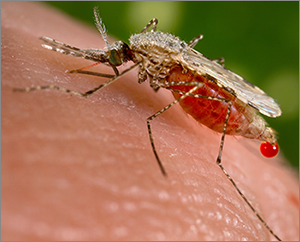A unanimous international consensus reached by 26 scientists recommends specific measures for the responsible conduct of gene drive research
(BOSTON) — Gene drives are genetic elements — found naturally in the genomes of most of the world’s organisms — that increase the chance of the gene they carry being passed on to all offspring, and thus, they can quickly spread through populations. Looking to these natural systems, researchers around the world, including some Wyss Institute scientists, are developing synthetic gene drives that could one day be leveraged by humans to purposefully alter the traits of wild populations of organisms to prevent disease transmission and eradicate invasive species.
These synthetic gene drives, designed using an RNA-guided gene editing system called CRISPR, could one day improve human health and the environment by preventing mosquitoes and ticks from spreading diseases such as malaria and Lyme; by promoting sustainable agriculture through control of crop pests without the use of toxic pesticides and herbicides; and by protecting at-risk ecosystems from the spread of destructive, invasive species such as rats or cane toads.
However, the development of RNA-guided gene drive technology calls for enhanced safety measures due to its nearly unique capability to affect shared ecosystems should organisms containing synthetic gene drives be accidentally or deliberately released from a laboratory. This potential risk is especially relevant to gene drive research in highly mobile species such as fruit flies or mosquitoes.
“One of the great successes of engineering is the development of safety features, such as the rounding of sharp corners on objects and the invention of airbags for cars, and in biological engineering we want to emulate the process of designing safety features in ways relevant to the technologies we develop,” said Wyss Core Faculty member George Church, Ph.D., who leads the Synthetic Biology Platform at the Wyss Institute and is also the Robert Winthrop Professor of Genetics at Harvard Medical School and Professor of Health Sciences and Technology at Harvard and MIT.
At the Wyss Institute, enhanced protocols for safely and securely researching emerging biotechnologies, including RNA-guided gene drives, have already been formally implemented. The safeguards were put in place proactively, step-by-step, in direct parallel with the development of the first RNA-guided gene drives at the Wyss Institute. The working documents have been made publicly available by the Institute to encourage widespread adoption of multi-tier confinement and risk assessment procedures. Church was instrumental in the design of the enhanced biosafety and biosecurity protocols.
Now, research teams from the Wyss Institute and University of California, San Diego – the only two groups to have published work on RNA-guided CRISPR gene drives – have proactively assembled an international group of 26 experts, including prominent genetic engineers and fruit fly geneticists, to unanimously recommend a series of pre-emptive measures to safeguard gene drive research.
Led by Wyss Institute Technology Development Fellow, Kevin Esvelt, Ph.D., and UC San Diego Professor of Cell and Developmental Biology Ethan Bier, Ph.D., the 26 authors of this consensus recommendation, which is published online in Science Express journal and includes representatives from every major group known to be working on gene drives, calls for all researchers to use multiple confinement strategies in order to prevent the accidental alteration of wild populations. The group also provides explicit recommended guidelines for regulatory authorities evaluating proposed new work. Furthermore, the group hopes the consensus will launch broadly inclusive discussions concerning the need for transparency and public involvement in this nascent scientific field.
“Just as we demand informed consent in healthcare, people have the right to know about the development of gene drives or other technologies that could directly impact their lives,” said Esvelt.
Motivated by concerns over intellectual primacy and property, scientists rarely disclose new research until it is published in peer-reviewed journals. Esvelt and others are hopeful that the field of gene drive research is so nascent that it may be possible to build a community of scientists that share their research with the public throughout the development process.

“This would promote collaboration and avoid needless duplication of efforts among different research groups while allowing diverse voices to help guide the development of a technology that could improve our shared world,” said Esvelt. “And eventually, it might inspire a similar shift towards full transparency in other scientific fields of collective public importance.”
“The scientific community has a responsibility to the public and to the environment to constantly assess how new biotechnologies could potentially impact our world,” said Wyss Institute Founding Director Donald E. Ingber, M.D., Ph.D. “This proactive consensus recommendation — reached in an extraordinary demonstration of the power of scientific collaboration over competition — provides concrete, useful guidelines for safeguarding our shared ecosystem while ensuring that remarkable breakthroughs, such as synthetic gene drives, can be applied to their full potential for the greater good.”
